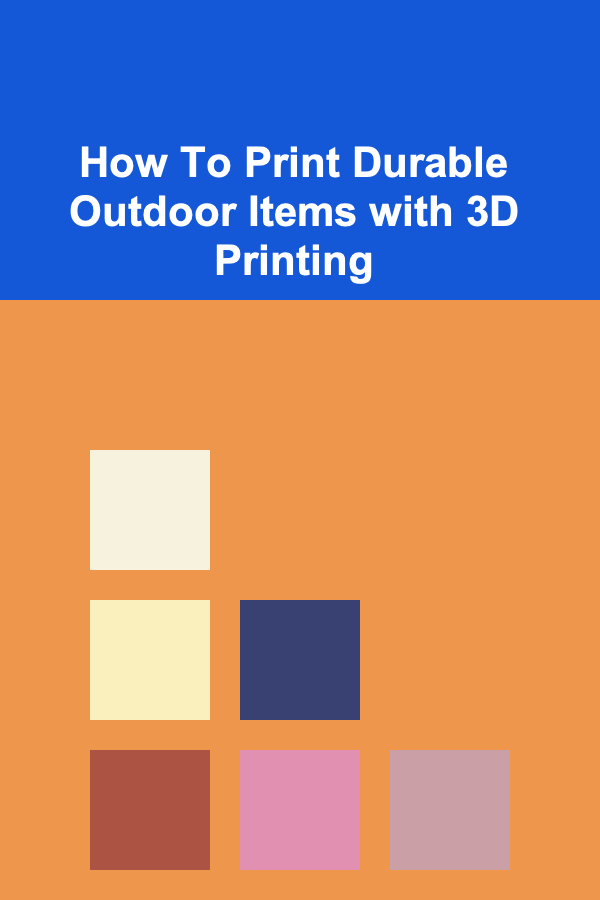
How To Print Durable Outdoor Items with 3D Printing
ebook include PDF & Audio bundle (Micro Guide)
$12.99$9.99
Limited Time Offer! Order within the next:

3D printing has revolutionized manufacturing across multiple industries, and one of the most exciting applications is in creating durable outdoor items. From garden tools and sporting equipment to structural elements for outdoor furniture, 3D printing offers unique solutions for producing customized, high-performance items that can withstand the harsh conditions of the outdoors.
In this article, we will explore how to print durable outdoor items using 3D printing. This includes selecting the right materials, the various types of 3D printing technologies available, design considerations, and post-processing techniques that ensure the longevity and durability of your 3D printed outdoor items.
Understanding 3D Printing for Outdoor Items
3D printing, also known as additive manufacturing, is the process of creating three-dimensional objects from a digital file. A printer builds these objects layer by layer, using materials such as plastic, metal, resin, or even concrete. In the case of outdoor items, durability is a critical factor since these items are exposed to extreme weather conditions like UV radiation, moisture, heat, and mechanical wear and tear.
The key to successfully printing outdoor items lies not only in selecting the right 3D printing material but also in ensuring the object design is optimized for strength and resilience.
Key Factors Affecting Durability in Outdoor 3D Printing
Before diving into specific 3D printing methods and material choices, it's important to understand the key factors that affect the durability of printed outdoor items:
- UV Resistance: Outdoor items are exposed to prolonged sunlight, and UV radiation can degrade many materials. This leads to discoloration, brittleness, and reduced strength over time. Materials that resist UV degradation are critical for items used outdoors.
- Moisture Resistance: Exposure to rain, humidity, and other moisture can cause warping, degradation, and weakening of certain materials. For this reason, selecting materials with moisture-resistant properties is essential.
- Thermal Resistance: Outdoor items are also subjected to temperature extremes, from freezing cold to intense heat. Materials must maintain their structural integrity under these conditions without warping or melting.
- Mechanical Strength: Items used in outdoor settings often undergo mechanical stresses such as bending, twisting, or impact. Ensuring that printed items can withstand these forces is key to their long-term durability.
- Chemical Resistance: Exposure to outdoor elements like soil, chemicals, oils, and fertilizers can degrade certain materials. Choosing a material that resists chemical wear is crucial for applications such as gardening tools or outdoor signage.
Materials for Durable Outdoor 3D Printing
The choice of material plays a significant role in the overall durability of a 3D printed object, particularly for items used outdoors. Here's a closer look at the best materials for printing durable outdoor items:
1. ABS (Acrylonitrile Butadiene Styrene)
ABS is one of the most common materials used in 3D printing due to its strength, durability, and impact resistance. It is also relatively resistant to UV light, making it a suitable choice for outdoor applications. Additionally, ABS can withstand higher temperatures than other thermoplastics, which is essential for items exposed to direct sunlight or heat.
However, ABS is prone to warping during the printing process, especially on larger objects. It also requires a heated print bed to ensure a proper bond between layers.
Best for: Garden tools, outdoor toys, brackets, and structural components for furniture.
2. PETG (Polyethylene Terephthalate Glycol)
PETG is a popular material for 3D printing because it offers a combination of strength, flexibility, and resistance to moisture. It is more weather-resistant than ABS and has better impact resistance. PETG also has good UV resistance and can handle extreme temperatures, making it suitable for outdoor use.
PETG is easy to print with, and its flexibility reduces the risk of cracking or breaking under mechanical stress. It is a great material for objects that will undergo repeated movement or force, such as parts of outdoor equipment.
Best for: Outdoor planters, water-resistant enclosures, gardening tools, and wear-resistant parts.
3. Nylon
Nylon is a versatile material known for its excellent mechanical properties. It has high tensile strength and resistance to abrasion, which is perfect for outdoor items that will endure mechanical stress and wear. Nylon is also resistant to moisture, which makes it a good choice for outdoor items exposed to rain or humidity.
One downside of nylon is that it can absorb moisture over time, which may lead to warping during printing. However, specialized nylon filaments such as NylonX (with carbon fiber reinforcement) offer enhanced durability for demanding outdoor applications.
Best for: Mechanical parts, outdoor furniture hardware, and heavy-duty garden tools.
4. Polycarbonate (PC)
Polycarbonate is an extremely durable material, often used in applications requiring high impact resistance. It has excellent UV resistance, thermal stability, and is one of the strongest plastics available for 3D printing. Polycarbonate can withstand extreme temperatures and harsh weather conditions without losing structural integrity, making it ideal for durable outdoor items.
However, polycarbonate can be challenging to print due to its high printing temperature, so a high-quality 3D printer with a heated bed and an enclosed chamber is recommended.
Best for: Structural components, outdoor lighting fixtures, and heavy-duty outdoor equipment.
5. TPU (Thermoplastic Polyurethane)
TPU is a flexible filament, offering excellent durability and elasticity. While not as rigid as other materials, TPU is highly resistant to wear, abrasion, and environmental factors like UV radiation. It's an ideal material for printing items that need to be flexible, such as outdoor footwear or protective covers.
Best for: Flexible components, outdoor sports gear, gaskets, and cushioning materials.
3D Printing Technologies for Outdoor Items
While material selection is critical for ensuring durability, the printing technology used also impacts the quality of the final product. The two primary 3D printing technologies suitable for creating durable outdoor items are:
1. Fused Deposition Modeling (FDM)
FDM is one of the most common 3D printing methods. It involves heating a filament of material and extruding it layer by layer to build the object. FDM is cost-effective and supports a wide range of materials, including ABS, PETG, and nylon.
FDM printing is ideal for outdoor items because of its ability to create strong, durable parts with fine detail. However, the print quality and strength can be affected by factors such as layer adhesion, extrusion speed, and temperature.
Best for: Budget-friendly, durable outdoor tools, enclosures, and custom parts.
2. Stereolithography (SLA)
SLA uses a laser to cure liquid resin layer by layer. It produces highly detailed prints with smooth finishes, which is beneficial for creating outdoor items with intricate designs. While SLA prints can have excellent mechanical properties, resin materials used in SLA are often more brittle than those used in FDM printing.
To improve durability, SLA users may opt for tough resins that are specifically designed for outdoor applications. These resins often feature higher impact resistance and can be treated for UV and moisture resistance.
Best for: Small outdoor decorative items, models, and complex designs.
Optimizing Designs for Durability
Designing for 3D printing, especially for outdoor items, requires careful attention to detail. Here are a few design considerations to enhance the durability of your outdoor 3D prints:
- Layer Orientation: The orientation of the object on the print bed can affect its strength. Objects printed with layers parallel to the force applied (such as weight or stress) are more likely to fail. By optimizing layer orientation to align with expected stress, the item can be made more durable.
- Infill Density and Pattern: The infill density of your print determines the internal structure of your object. Higher infill percentages (such as 70%-100%) offer more strength, while lower infill percentages reduce material usage but can weaken the final product. The infill pattern (such as grid, honeycomb, or cubic) also influences strength, with cubic patterns generally offering the best performance.
- Wall Thickness: Increasing the number of outer walls will improve the strength of your 3D printed object. A thicker outer shell helps protect against mechanical forces and impacts, particularly for outdoor tools and equipment.
- Support Structures: Proper support structures are necessary to prevent deformation or sagging during printing, particularly for larger prints. These supports ensure that overhangs or complex geometries remain intact during the build process.
- Post-Processing and Coating: After printing, post-processing steps such as sanding, priming, and coating with protective layers (e.g., UV-resistant coatings) can enhance the durability of your outdoor items. These steps can help seal the surface and provide additional protection against moisture, UV light, and abrasion.
Conclusion
3D printing offers exciting possibilities for creating durable outdoor items. By selecting the right materials, employing suitable printing technologies, and optimizing your designs, you can produce items that can withstand the elements and perform well in challenging outdoor environments. Whether you're creating garden tools, sporting equipment, or structural components, the ability to customize and print durable outdoor products gives you the flexibility to meet your exact needs.
Remember, the durability of a 3D printed item isn't solely dependent on the printing process itself---post-processing and maintenance are also crucial for ensuring the longevity of outdoor items. By keeping these factors in mind, you can harness the full potential of 3D printing for creating long-lasting, high-performance outdoor products.
Reading More From Our Other Websites
- [Home Renovating 101] How to Renovate Your Home for a Family-Friendly Layout
- [Organization Tip 101] How to Choose the Right Shelving for Your Closet Needs
- [Home Budget 101] How to Save Money on Furniture and Home Appliances
- [Personal Care Tips 101] How to Do Meal Prep for Diabetics on a Budget
- [Small Business 101] Top 5 Best Business Loans for Small Businesses and How to Qualify
- [Home Staging 101] How to Stage Your Home in Preparation for a Move
- [Personal Care Tips 101] How to Use Deodorant to Ensure Freshness After a Long Day
- [Personal Care Tips 101] How to Choose the Best Hair Mousse for Your Styling Needs
- [Home Renovating 101] How to Estimate Roof Replacement Cost and Avoid Overpaying
- [Home Soundproofing 101] How to Soundproof a Ceiling to Block Noise from Upstairs

How to Build Wealth with a Long-Term Stock Investment Strategy
Read More
How to Create an Organized Home Office for Remote Work
Read More
How to Identify the Right Processes to Automate in Small Businesses
Read More
How to Offer Green and Energy-Efficient Features in Your Rental Property
Read More
How to Use Pegboards for Fishing Gear Organization
Read More
10 Tips for Debugging Machine Learning Models
Read MoreOther Products

How to Build Wealth with a Long-Term Stock Investment Strategy
Read More
How to Create an Organized Home Office for Remote Work
Read More
How to Identify the Right Processes to Automate in Small Businesses
Read More
How to Offer Green and Energy-Efficient Features in Your Rental Property
Read More
How to Use Pegboards for Fishing Gear Organization
Read More